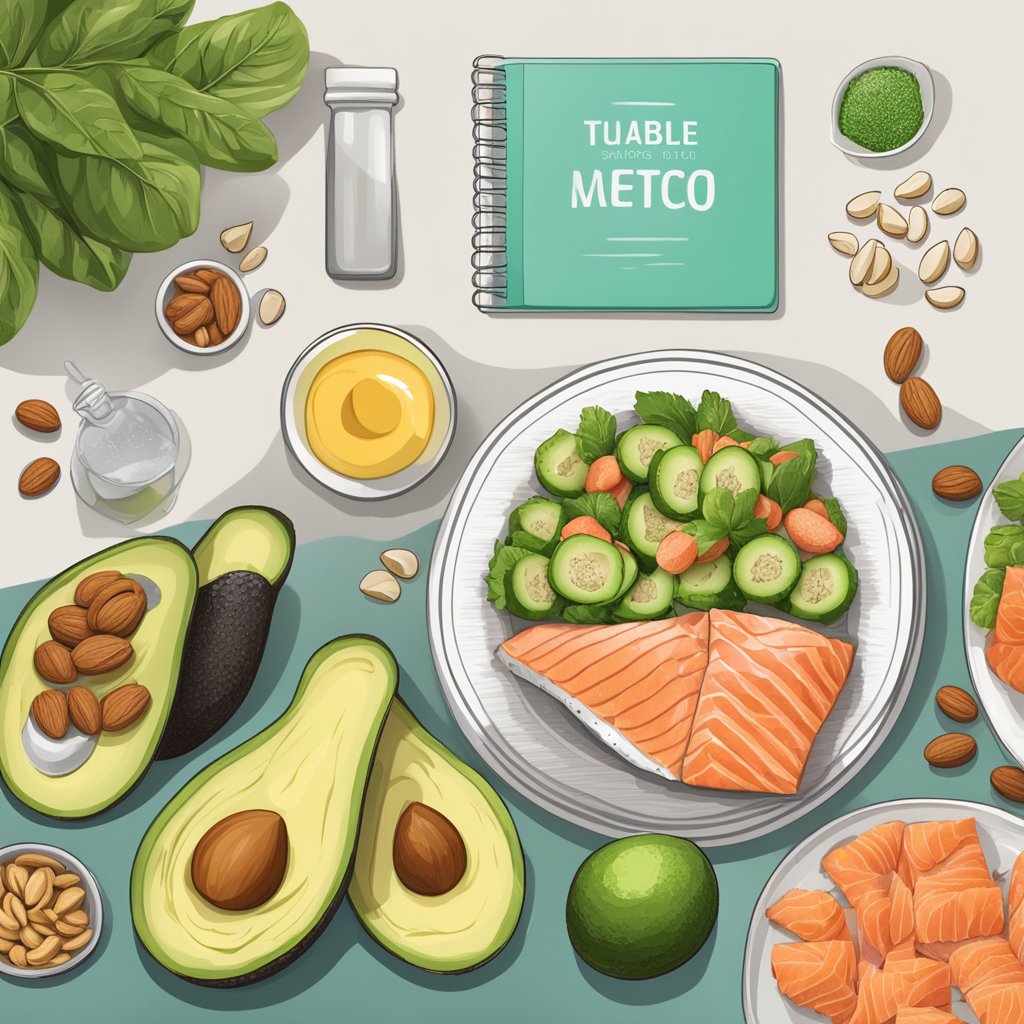If you’re exploring the world of health and nutrition, you’ve probably heard chatter about the ketogenic diet plan, or “keto” diet for short. This particular eating plan, characterized by low-carb eating and high-fat intake, has gained significant traction due to its potential in weight loss, blood sugar regulation, and other health benefits. But what exactly is the keto diet, and how does it impact your body?

What is the Ketogenic Diet?
The ketogenic diet involves significantly reducing your carbohydrate intake while increasing the consumption of healthy fats. This dietary adjustment leads your body into a metabolic state called nutritional ketosis. In this state, instead of using glucose from carbohydrates, your body starts burning stored fat as a source of energy. This shift contributes to weight loss, better blood sugar control, and potential health improvements. However, it’s crucial to consult a healthcare professional before starting any diet or nutrition plan, especially the ketogeneic diet.
Exploring the Origins
Originating in the 1920s as a treatment for epilepsy, the ketogenic diet faded from the spotlight with the emergence of anticonvulsant drugs. In recent times, it has resurfaced, gaining popularity in the fitness and nutrition realms for weight loss and overall health enhancement.
Ketogenic Diet Advantages and Disadvantages
The ketogenic diet presents various advantages:
- Rapid weight loss, especially in the initial stages.
- Increased energy levels and enhanced focus.
- Reduced appetite and food cravings due to the high-fat intake.
- On the flip side, some disadvantages include:
- Difficulty in adherence, particularly in social situations with tempting high-carb options.
- Potential nutrient deficiencies, requiring supplementation.
- Elevated risk of heart disease if unhealthy fats are consumed regularly.
Macronutrients in the Ketogenic Diet
Keto diet meals adhere to a specific macronutrient composition, typically comprising 70-80% of calories from fat, 20-25% from protein, and 5-10% from carbs. This ratio aims to trigger and maintain optimal ketosis, encouraging the body to burn body fat for fuel rather than glucose.
Fuel Sources on the Ketogenic Diet
Primary energy sources on the keto diet include healthy fats like olive oil, coconut oil, avocados, nuts, and seeds. You can get your moderate protein intake from sources like meat, poultry, fish, and eggs is also essential. Carbohydrates are limited and ideally derived from non-starchy vegetables such as leafy greens, broccoli, cauliflower, and zucchini.
Optimal Ratios
Maintaining the correct ratio of fat to protein to carbohydrates is crucial for achieving and sustaining optimal ketosis. High-fat content helps with satiety, while restricted carb intake stabilizes blood sugar levels. Protein is necessary for essential amino acids and muscle maintenance.
Determining Carb Intake
Most individuals aim for fewer than 50 grams of net carbohydrates per day. Calculating net carbs involves subtracting the fiber content from the total carbohydrate amount.
Allowed and Restricted Food Choices
Permitted foods on the ketogenic diet include healthy fats, non-starchy vegetables, meats, nuts, and seeds. Foods to avoid consist of high-carb items like bread, pasta, rice, sugary treats, and processed snacks.
Health Benefits of the Ketogenic Diet
Besides weight loss, the keto diet offers significant benefits to existing health conditions:
- Improved Blood Pressure: By curbing blood sugar spikes, the diet aids in lowering high blood pressure, a major risk factor for heart disease.
- Blood Sugar Control: Reduced carbohydrate intake helps manage glucose levels, potentially reducing the risk of type 2 diabetes.
Is the Keto Diet Safe?
While generally safe, ketogenic diets may not suit everyone. Common side effects include “keto flu,” fatigue, constipation, and a possible increased risk of kidney stones or ketoacidosis. Monitoring cholesterol levels, blood pressure, liver health, and nutrient intake is crucial.
Keto Diet Side Effects
Managing Potential Effects of the Keto Diet
As you embark on the keto diet for weight loss, it’s important to understand some potential effects your body might experience during the adjustment phase.
1. Transition Period: Energy Shift
When transitioning from burning glucose (sugar) to burning fat for energy, some individuals may experience what’s often referred to as the “keto flu.” This collection of symptoms, including fatigue, headaches, and muscle cramps, may arise. These sensations occur as your body adapts to using fat for fuel instead of its typical glucose source.
2. Combating Fatigue: Fuel and Hydration
Fatigue is common during this transition as your body adjusts. Ensure you’re consuming enough calories and electrolytes, while also staying adequately hydrated, to alleviate this temporary fatigue.
3. Addressing Constipation: Fiber Intake
Constipation might occur due to the diet’s lower fiber content. Prioritize high-fiber foods like leafy greens and nuts to counteract this issue and maintain digestive health.
4. Reducing Kidney Stone Risk: Hydration Matters
Some concerns exist about increased kidney stone risk due to higher protein intake leading to higher calcium in urine. Staying well-hydrated and discussing any concerns with your healthcare provider can help mitigate this risk.
5. Monitoring Acid Levels: Ketoacidosis Awareness
In rare instances, the ketogenic diet might lead to a serious condition called ketoacidosis, characterized by excessive blood acid levels. Monitor blood ketone levels and seek medical advice if symptoms like nausea or vomiting occur.
6. Keeping Tabs on Cholesterol: Diet Impact
The ketogenic diet may impact cholesterol levels, potentially increasing both good (HDL) and bad (LDL) cholesterol. Regular monitoring and discussions with your healthcare provider are crucial to address any concerns.
7. Blood Pressure Considerations
There’s some evidence suggesting the ketogenic diet might assist in lowering blood pressure for some individuals. Regularly monitoring blood pressure and discussing any changes with your healthcare provider is recommended.
8. Liver Health Concerns
For those with pre-existing liver conditions, there’s some concern about the diet’s impact on liver health. Discuss any concerns about how the diet might affect your liver with your healthcare provider.
9. Handling Headaches: Calorie Intake and Hydration
Headaches might occur initially due to the diet’s low carbohydrate content, potentially causing a drop in blood sugar. Ensuring sufficient calorie intake and staying hydrated can help alleviate this discomfort.
10. Managing Muscle Cramps: Electrolyte Balance
Muscle cramps might arise due to the diet’s lower electrolyte content like sodium, potassium, and magnesium. Ensure you’re consuming enough electrolytes either through your diet or via supplements to counteract this issue.
Remember, these effects are often temporary as your body adapts to this dietary shift. It’s essential to stay informed and consult your healthcare provider to address any concerns or experiences you encounter while following the ketogenic diet.
Nutrient Factors to Address
The ketogenic diet has gained significant popularity as a low-carbohydrate diet plan in recent years. While adopting this dietary approach can result in weight loss and enhanced health, it’s essential to take into account various nutrient factors to guarantee an adequate intake of vital vitamins and minerals necessary for overall well-being
What are the 9 Rules of Keto

When following a ketogenic diet, it’s essential to keep the following rules in mind:
1. Limit your carbohydrate intake to 20-50 grams per day.
2. Increase your intake of healthy fats, such as olive oil and avocado.
3. Include high-quality protein sources in your meals.
4. Avoid processed and refined foods.
5. Incorporate plenty of low-carb vegetables into your diet.
6. Stay hydrated by drinking plenty of water.
7. Consider supplementing with electrolytes to prevent dehydration.
8. Monitor your calorie intake to ensure you’re in a calorie deficit.
9. Work with a registered dietitian to create a meal plan that meets your specific needs.
Choosing Keto-Friendly Foods
Examples of suitable keto foods include meat, fish, eggs, nuts, seeds, avocado, oils, and low-carb vegetables. Incorporating fiber-rich foods such as berries and additional vegetables helps maintain digestive health.
In conclusion, embracing the ketogenic diet offers a promising path toward weight loss and overall health improvement. However, understanding nutrient factors and collaborating with a registered dietitian are key to ensuring a balanced and sustainable approach to this dietary regimen.
Frequently Asked Questions
Q: How does the ketogenic diet contribute to weight loss?
A: The ketogenic diet aids weight loss by prompting the body to utilize fat for energy instead of carbohydrates. This metabolic state, known as ketosis, occurs when limited carbohydrates are available for energy. By reducing carbs and increasing fat intake, the body switches to burning stored fat, leading to potential weight loss.
Q: What are the possible risks linked with the ketogenic diet?
A: Certain risks associated with the ketogenic diet may include potential nutrient deficiencies, constipation, and dehydration. It’s vital to ensure adequate intake of essential vitamins and minerals, maintain hydration, and consume sufficient fiber to prevent constipation. Some individuals might experience initial symptoms like headaches, fatigue, or irritability, known as the “keto flu.”
Q: What are the primary health advantages of adopting a ketogenic diet?
A: Key health benefits of the ketogenic diet include better control of blood sugar levels, increased energy, and potential reduction in inflammation. Some studies suggest its potential benefits for specific medical conditions like epilepsy and type 2 diabetes.
Q: Can you explain the nutritional approach of the ketogenic diet?
A: The ketogenic diet emphasizes a high-fat, moderate-protein, and low-carbohydrate approach. Typically, individuals on this diet aim for 70-80% of calories from fat, 20-25% from protein, and 5-10% from carbohydrates. This strategy encourages the body to enter nutritional ketosis, where fat becomes the primary energy source instead of carbs.
Q: What are some simple keto recipes suitable for beginners?
A: Beginner-friendly keto recipes include easy-to-make options like avocado and egg breakfast, cauliflower rice stir-fry, and zucchini noodles with pesto. These recipes are straightforward and utilize ingredients commonly found in a ketogenic diet.
Q: Which foods should individuals avoid when following a ketogenic diet?
A: Foods high in carbohydrates, such as bread, pasta, rice, potatoes, and sugary desserts, should be avoided on a ketogenic diet. Some fruits with high sugar content, like bananas and grapes, should also be limited. Instead, prioritize foods high in healthy fats, such as avocados, nuts, and fatty fish.
